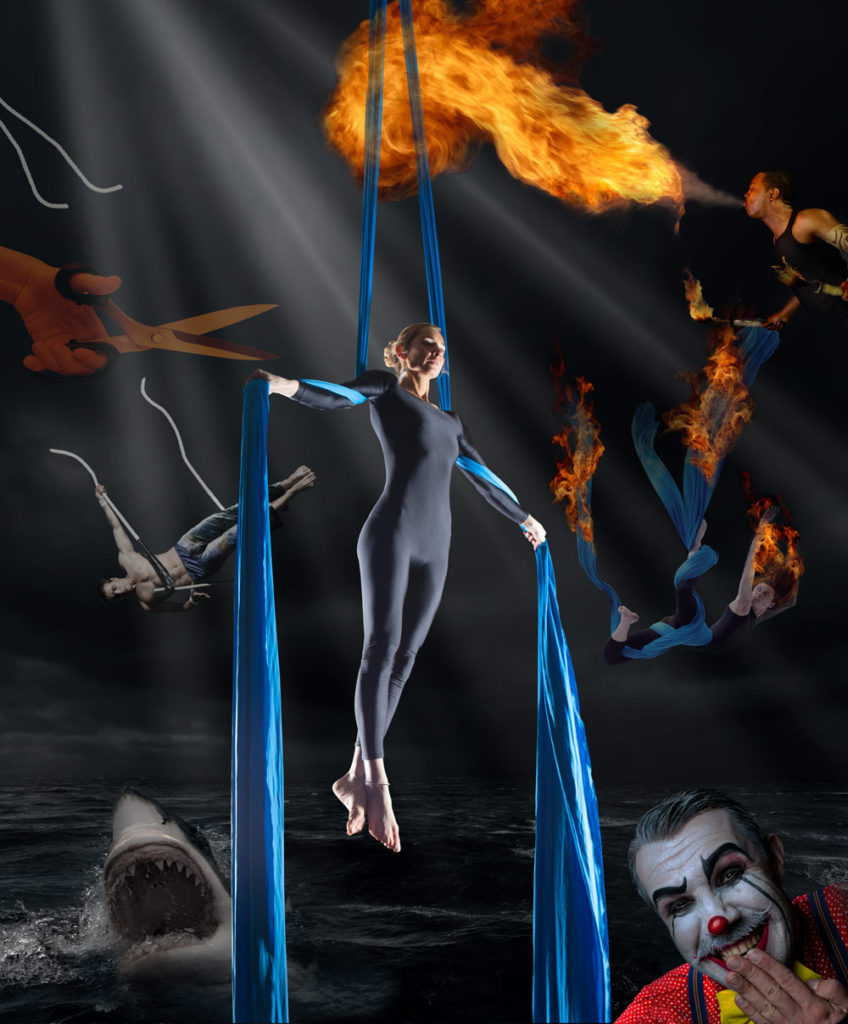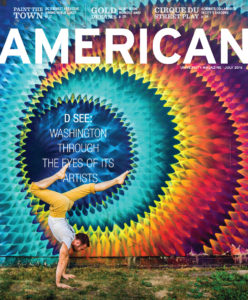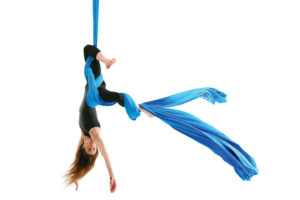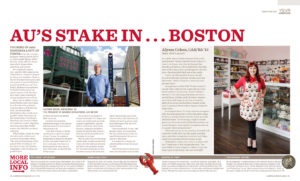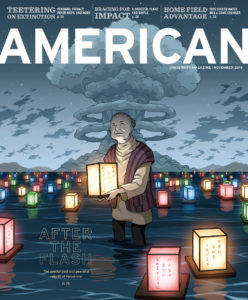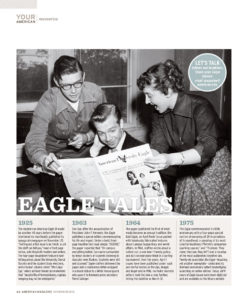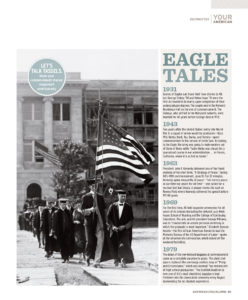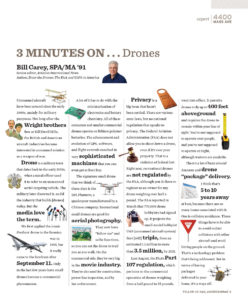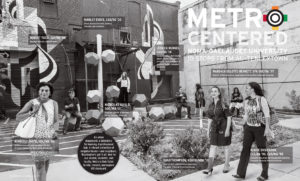MAYHEM TO MAGIC
One editorial team’s journey from conflict to collaboration
By Adrienne Frank
I don’t remember how the argument started — but I’ll never forget how it ended.
Six years ago, our magazine team, united only in name, gathered to discuss the upcoming issue of American. One of the designers made a snide comment and an editor, a woman who was as polished as the pearls she sometimes wore to work, snapped. She smacked the table, shouted an expletive, and stormed out of the building.
It was like a scene out of Real Housewives.
She eventually returned to the office — and thank goodness, as she was a very skilled editor — but we never addressed that conflict as a group. It became a dark cloud that hovered over the editorial staff’s already stormy relationship with the designers. A proverbial wall split our magazine team in two and after years of miscommunication and bruised egos, she wasn’t the only one employing the occasional four-letter word.
BEFORE I tell you if we turned things around (spoiler alert, we did), I want you to think about your own teams for a moment. Do any of the following toxic dynamics sound familiar?
Roles, expectations, and processes are ambiguous. The team avoids conflict entirely — or revels in drama and crises. Decisions are revisited after they’ve been made. There’s no common purpose or excitement around the work. The same two people do all the talking — and they don’t really know what they’re talking about. The team is constantly putting out fires; there’s no time to plan ahead, experiment, or play. Meetings, which are soul-crushing in number, are used primarily for information sharing. Good, productive workers flee. Interactions are tense and aggressive, resulting in: mistrust, tears, and absolute misery for eight hours per day.
I’ve been there. And I know you have, too. (Otherwise you wouldn’t be reading this story.)
The good news: It can get better. With a few small tweaks, some of which you can make today, you can begin to build stronger, more agile, more creative teams.
I firmly believe that as editors, writers, designers, and art directors, we have the best job in the world: making a magazine. Since I started my own rag (Frankly Speaking) at the tender age of 8, this is all I’ve ever wanted to do. And now that I’m six years removed from that reality TV-esque blowup, I can tell you that I’m happy 90 percent of the time in my job. (The remaining 10 percent is spent complaining about the mailing list.) Our daily misery should be limited to 30 minutes, tops. And by adopting the five mantras detailed in this story, it can be.
BY NOW, you’re probably wondering who, exactly, I am (answer: not a therapist) — and thus, what qualifies me to dole out the advice that follows.
As managing editor of American magazine, I’m one-third of the small but mighty team that produces American University’s flagship publication. Writer Mike Unger and designer Maria Jackson round out the staff.
We publish three times a year for 130,000 alumni — 42 percent of whom live in the Washington, DC, area. We’re editorially independent, for the most part. Like any alumni magazine, we have to cover some institutional news (campus construction, donor profiles), but we’re able to determine the way in which we tell those stories.
We redesigned the magazine internally in 2012 — a year after table smack heard ‘round northwest Washington. The redesign came amidst a division-wide reorganization that saw our team shrink from six to three. It marked not only a change in the look and feel of the magazine, but also in the way we produced it. Lots of good stuff came out of the redesign: a couple of awards, a reinvigorated staff, a streamlined editorial calendar, and more than a dozen anchor pages. Wait, anchor pages?
Whenever I explain the concept of anchor pages to someone (which I do a lot — I’m really passionate about them), I site Babybug, a magazine for kids 3 and under. When he was younger, my son Owen received the magazine every other month. He especially enjoyed “Kim and Carrots,” a six-page story about a little girl and her stuffed rabbit that always ran in the front of the magazine.
When the third issued appeared in our mailbox, Owen squealed, “Kim and Carrots!”
That’s an anchor page. It’s something that readers anticipate and that leaves them satisfied, even if it’s the only thing they read. Anchor pages, which appear in the same place and maintain the same look from issue-to-issue, set expectations for your readers. They’re memorable; they resonate.
And from an editorial planning perspective, they can make your job a lot easier, as you’re not reinventing the wheel with each issue. Pre-redesign, American was a mess, and that dynamic bled into how we functioned as a team. We needed to be more thoughtful, consistent, strategic, and creative. That’s the beauty of anchor pages: They provide structure and consistency, but they also give you flexibility, as they offer a place for every kind of story. Anchor pages also enable you to subtly incorporate branding initiatives and feed your digital presence, whether a website or social media feeds.
(Whew, I told you I’m passionate about anchor pages. Keep them in mind, as they’re going to come up again as we delve into teambuilding.)
There’s no question that the redesign was a turning point for our team. In the five years since, we’ve developed five mantras that inform both the work itself and how we work with one another. I explain these mantras below and hope you find them useful.
COMEDIAN Amy Poehler once said: “As you navigate through the rest of your life, be open to collaboration. Other people’s ideas are often better than your own. Find a group of people who challenge and inspire you, spend a lot of time with them, and it will change your life.”
My life has been changed by the wonderful creative team we’ve built — through blood, sweat, and more than a few tears — at American magazine. And I wish for you the same professional happiness. At least 90 percent of the time.
MANTRA NO. 1: Check your ego and trust your teammates
As a team, our guiding principle is “no idea is a bad idea.” (And, in fact, the best idea might not be your idea.) Pre-redesign, ideas were shut down quickly in brainstorming meetings, and we were often told, “We tried that before, and it didn’t work.” Or, simply, “It won’t work.” In the five years since then, we’ve nurtured a culture of respect and collaboration. We want everyone to feel safe to share even the craziest of ideas, which often snowball into something special.
Trust is at the heart of our team; that’s why we’re also comfortable enough with each other to be honest when something isn’t working. But even if we disagree — about the direction of a story or a design element — that never devolves into someone cursing, slamming, or doing laps around the building to cool off.
Another hallmark of our team, post-redesign: There are no walls between editorial and design. Previously, designers weren’t brought into the process until the stories were written. There was no collaboration, no brainstorming — an absolute missed opportunity, since on more than one occasion, Maria’s come up with a winning headline or Mike’s had a great idea for an image. The three of us are involved with most aspects of production from the beginning — we even attend all photo shoots together. Thus, everyone is equally invested in the work.
MANTRA No. 2: Challenge yourself
Creativity is vital to our profession. Often we have to tell the same stories over and over (think: commencement). It’s easy to fall into the rut of “good enough.” But our team thrives on pushing the limits of our creativity and telling stories in a way we’ve never
done before.
It’s important to nurture your creativity, and we do that by looking at lots of other magazines — both commercial and alumni publications — and tearing out the stories, headlines, infographics, designs, photos, and type treatments that inspire us. Maria and I have several notebooks we look to when we’re stuck and searching for the spark of an idea. We also use the notebooks as a repository for things we want to try in the magazine.
If you’ve got the money in your budget, I recommend going to the bookstore as a group and spending $100 on magazines, then gathering back at the office to talk about what you like. You can begin to seed your inspiration books — and brainstorm ideas for anchor pages — with those magazines.
I’m old-school: I will never describe myself as “a creative.” (“Creative” is an adjective, dammit.) But as a writer and editor, creativity is my lifeblood. I’m a ravenous reader and am immensely curious about the world, as are Maria and Mike. Fascinating ideas abound — you just have to challenge yourself to unearth them.
MANTRA No. 3: Communicate
It sounds simple. I assure you, it’s not.
It seems counterintuitive, but one of the first things we did to improve our communication as a team was to slowly and steadily do away with meetings. Pre-redesign, we had three or four meetings a week — often more if whatever we were supposed to accomplish in the course of the meeting didn’t get accomplished. No one likes a meeting, especially one without a clear purpose — or a meeting where everyone’s mandated to bring a story idea. (I staunchly believe that the best ideas are born organically.)
Now, instead of status meetings, we just stop by each other’s desks several times a day to check in and ask for feedback or help. Our communication conveys much more information, but it’s also more to-the-point and less time-consuming than a meeting. We also do a lot of things on email or by text. In the past, we might’ve had an hour-long meeting to come up with a single headline. Now we hash it out across our desks, or by text if inspiration strikes outside the office.
A few other quick notes on communication: Criticism is constructive, and if we have something negative to say, we’ll always start with what worked. That’s just the kind thing to do. If conflict does arise — and I’d be lying if I said it didn’t — it’s squashed quickly. In the past, we had people on the team who would argue and swear never to work with or even speak to each other again. If there’s some tension on our team, it’s addressed quickly and forgotten. It never interferes with the work.
MANTRA No. 4: Embrace flexibility — and structure
Anchor pages have transformed the way we work. Even though our staff shrunk, we’re doing more with less. The structure that the anchor pages provide — remember, they appear in the same place and maintain the same look and word count from issue to issue — has made us more efficient and creative, but also more agile when we need to be.
For the first time ever, we’re not in firefighter mode. We’re planning two issues ahead, which gives us plenty of backup options if a story falls through or we need to switch things around to achieve a better balance in the magazine. The editorial process is marked by structure and strategy — not chaos. Additionally, we have a place for every kind of story in the magazine. Previously, a piece about the two alumni who started DC’s first local coffee roasting company would’ve ended up in the feature well. Now, thanks to anchor pages, we can ask them to “unpack” the tools of their trade or challenge them to pick their 10 favorite Washington coffee shops.
We also maintain consistent word counts for every story in the redesigned magazine, which helps writer and designer alike. (Although the writers among us — myself included — always hope to squeeze in a few more words here and there.)
MANTRA No. 5: Have fun
American doesn’t focus on the usual suspects. We’ve featured an interesting, eclectic mix of people in the magazine: a fighter pilot, a mystery writer, Olympic hopefuls, a plane crash survivor, cartoonists, an expert on dying languages. We’ve gone to the White House, the Capitol, the National Aquarium in Baltimore, and the governor’s mansion in Annapolis. That keeps us energized about our work, and I truly believe that excitement shines through the pages of our magazine.
A good publication has a strong sense of place — and we take every opportunity to embrace ours. Washington, DC, is an important part of American and the AU experience and we relish trying a new lunch spot or going to a local brewery for happy hour, as we do after the magazine goes to press. We like to celebrate our successes and remind ourselves of what we love about our work and the city where we do it.
Adrienne Frank is editor of American magazine, American University’s award-winning flagship publication. Before that, the last winning team she was a part of was her ninth grade club soccer squad. She definitely prefers scrambling to press over running suicides. Connect at tinyurl.com/linkedin-afrank.

